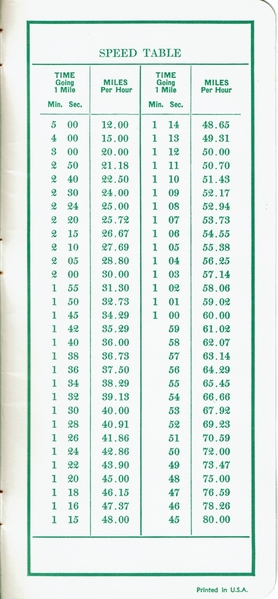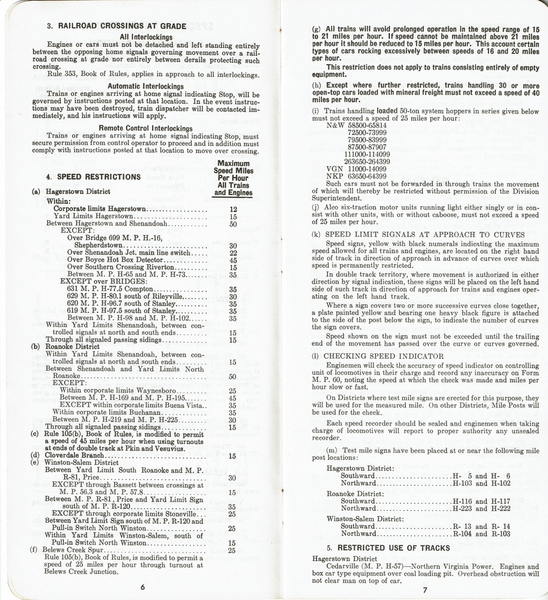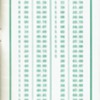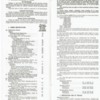Question for the real railroaders--how does one know the track speed limit?
Replies sorted oldest to newest
IC EC posted:Question for the real railroaders--how does one know the track speed limit?
The Engineer knows his territory, plus maximum track speeds are usually shown in the Employee Timetable for that district/division. Speed limits/reductions on curves, or other specific, have an advanced speed board, then generally a speed board at the actual beginning of the slower speed. Temporary speed restrictions are handled with a yellow flag/board, usually 2 miles prior to the actual "restriction".
Thanks, Hot Water.
To expand on Jack’s comments; my youngest son is an NS conductor. Before a trip; he prints out a listing of all speed restrictions, MOW work, what have you and keeps that on the “desk” in front of him during a trip and checks off as they progress.
Although the engineer actually controls the train, it is the responsibility of both the engineer and conductor to ensure all speed restrictions are complied with.
Curt
My $99 Garmin GPS posts the street speed limit on the display. Seems like the best way to provide up to date info would be provided with some very simple technology...
Just sayin' ![]()
Back in the day Track Speed was only Suggested Track speed. They only enforced it when you Wrecked. At least that is what one old head told me years ago while I was doing My Engineer On the job training. Don't try it today.![]()
In addition to the above, certain cars in a train (such as a MOW crane or a high-wide load) will determine a train's maximum speed. As an example, from a SLSF employee timetable:
Movement of Frisco derricks is authorized as follows:
100 ton 160 ton 250 ton
35 35 45
this accompanied by another 2 pages of special instructions. There is a large field of learning for beginning trainservice people.
I think the Speed signs are more of a Diesel Area thing according to some of the older Engineman I worked with. These guys had spent 2/3 of their careers on steam.
And No speedometers on CNR steam engines. ( get out the pocket watch... 40 telegraph poles to the mile)
Gregg posted:I think the Speed signs are more of a Diesel Area thing according to some of the older Engineman I worked with.
No they weren't. They even showed Frt/Pass speeds for the curves. Don't have time to upload a photo right now.
Big Jim posted:Gregg posted:I think the Speed signs are more of a Diesel Area thing according to some of the older Engineman I worked with.
No they weren't. They even showed Frt/Pass speeds for the curves. Don't have time to upload a photo right now.
Major railroads like the NYC, PRR, N&W, ACL, B&O, Erie, CB&Q, CMStP&P, C&NW, AT&SF, UP, SP, etc., all had "speed limits" well prior to diesel, i.e. prior to even the 1930s
Speed limitations in the steam era (at least) were also dependent upon the motive power. The Frisco spot-class 2-10-2s were restricted to a max of 35 mph because of the pounding they gave the rails.
eddiem posted:My $99 Garmin GPS posts the street speed limit on the display. Seems like the best way to provide up to date info would be provided with some very simple technology...
Just sayin'
Is that the same instrument that tells people to turn onto roads that do not exist and fails to recognize roads that do?
Surely, most railroads have some type of technology to assess speed compliance, if nothing more than a radar gun?
Tinplate Art posted:Surely, most railroads have some type of technology to assess speed compliance, if nothing more than a radar gun?
In this modern era, it is all recorder in the unit's event recorder, i.e. speed, when the horn is blown, when the brake is applied, throttle position, dynamic brake level, etc., etc., etc..
Tinplate Art posted:Surely, most railroads have some type of technology to assess speed compliance, if nothing more than a radar gun?
IN signalled territory (CTC) the time a signal drops would be recorded , I'm sure the time it takes to go between signals (a block)is a know.
Ex Time at track speed between signals is 10 minutes. you do it in 8 minutes,,, got ya.
We had a low-tech method at TVRM in the Summer of 1984, when I fired and ran Ex-SR #722 for eleven weeks: a hand-held radar gun on loan from NS. It did the job!
I have a old speed limit sign from the Santa Fe in western Oklahoma, The trains had to slow down to 55 MPH.
Gregg posted:I think the Speed signs are more of a Diesel Area thing according to some of the older Engineman I worked with. These guys had spent 2/3 of their careers on steam.
And No speedometers on CNR steam engines. ( get out the pocket watch... 40 telegraph poles to the mile)
Reminds me of a funny story Michael Crichton (the author/director) told about the filming of the movie "The Great Train Robbery" in Ireland. There was a scene they were filming where Sean Connery climbs on top of the train (I guess to run along the top of the train, I don't recall), and it was shot on a real moving train of the era.
The crew was supposed to keep the speed relatively slow (for obvious reasons), but when they actually shot the scene the train was moving pretty fast (Cricthton estimate it was well above 40MPH), and they radio'ed the engineer to stop the train. Connery came down, really angry, and asked the engineer why he was going so fast (I am sure in salty language), and the engineer claimed he he was going slow as asked. Noting that the engine, not surprising for an engine c1911 or so, didn't have a speedometer of any kind, he asked the engineer how he was determining his speed, and the engineer replied he was timing speed based on the telegraph polls, to which Connery replied "you were judging the <bleep> speed based on the <bleeping distance> between bloody Irish telegraph poles?!" and appeared ready to strangle the guy...and I am sure it was said probably with more than a few derogatory remarks about Irish railroad workers in general..... It is even more fun if you imagine it being said with Connery's wonderful voice and accent![]()
Merciful heavens, this simple subject is becoming unsimplified. While this is a bit overwhelming to newly-hired employees, it becomes uncomplicated and straightforward after the employee acquires enough experience.
The maximum allowable speed of a train or an engine at any location is determined by the Engineering Department, which has charge of all matters concerning track and bridges, and, on most railroads, signals. The weight and condition of rail, the tie condition, the ballast depth, and the degree of curvature augmented by the amount of superelevation of curves are measurements that are used to determine maximum allowable speeds. Federal Track Classification Standards, which use the same factors, and impose Federal maximum allowable speeds must not be exceeded, but a lower speed may be imposed by a railroad.
These maximum speeds are shown on engineering track charts, but Locomotive Engineers and Conductors receive the official notice of maximum allowable speeds through the Employee Timetable.
There is a Timetable section on System speed restrictions which are universal on that railroad:
- Maximum speed of certain cars, such as derricks, MofW cars, and Company Service cars such as scale cars, often with different maximum speeds on main tracks, branch lines, sidings, and through turnouts.
- Maximum speed of certain types of passenger equipment (e.g., heavyweight cars vs lightweight cars)
- Maximum speed of each class of locomotive operated by the railroad
- Maximum speed of light engines, engines not equipped with dynamic braking, engines operating in reverse, or engines not being operated from the leading locomotive unit
- Maximum speed of cars due to weight or length (e.g., empty cars, cars weighing in excess of 140 tons, trains exceeding 5,000 feet in length, trains weighing over 7,000 tons)
- Maximum speed during very hot and very cold ambient temperatures.
The District permanent speed restrictions are shown, identified by milepost location, on the Subdivision page. This would include:
- The maximum allowable speed for passenger trains and freight trains on that Subdivision or portion thereof
- The maximum authorized speed for portions of a Subdivision if they are not continuous over the entire Subdivision, such as part of a Subdivision being signaled and part non-signaled or "dark"; portions on mountain grades; and portions not engineered for high speed
- Speed restrictions of specific sidings and main track turnouts
- Speed restrictions on bridges and curves, identified by milepost
- Speed restrictions due to local ordinances, if any
- Speed restrictions during dining hours on passenger trains
- Equipment-specific speed restrictions applicable to specific locations.
The District temporary speed restrictions due to track conditions and maintenance work in progress are shown by milepost location in Track Bulletins issued to each crew at its on-duty point. Temporary speed restrictions supersede permanent speed restrictions in effect at the same location. In the distant past, this function was fulfilled by Train Orders. Likewise any equipment speed restrictions not already covered by System speed restrictions are shown in Track Bulletins. Examples of this might be high and wide loads that are restricted, and sometimes must be watched, when passing through truss bridges and other close clearance locations.
Speed signs do not govern the speed of trains. The allowable speed of a train is governed by Operating Rules (e.g., Yard Limits in non-signaled territory), by Timetable Special Instructions, and by Track Bulletins. Speed signs, if used -- and they vary in style and placement as each railroad sets its own standards for these -- are reminders, helpful to have, but not to rely upon. If speed signs are missing for any reason, the restrictions are still in effect and train crews are not excused from complying with them.
I am told that New York Central and some other railroads, primarily in the East, did not use speed signs, at certain periods, or, in other cases, ever. There is not, and never was, a requirement that a railroad post speed signs. In the modern age, however, with the abundance of plaintiff attorneys in practice, it would be foolish of a railroad to not post, and maintain, speed signs.
In the steam era, timetable and train order speeds were shown in seconds per mile, as most steam locomotives were not equipped with speed indicators. Since dieselization, timetable speeds have been shown in miles per hour, or in the case of countries using the metric system, kilometers per hour.
Excellent examples, Big Jim! ![]()








